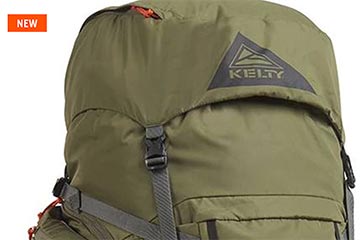The elements of an ecommerce product detail page should work together to help shoppers make sound buying decisions. Each element — prose description, a list of features, product photos, videos — should tell part of an item’s story.
Coyote 105
To witness this concept in practice, consider the product detail page for the Kelty Coyote 105 backpack as it appeared on Kelty’s website on August 28, 2020.
Photography. The Coyote 105 detail page contains a large product image positioned in the top left on desktop and top center on mobile. Beyond that, 10 more supporting images show the backpack from several angles. And, like many good ecommerce sites, Kelty allows users to zoom in on product pictures.
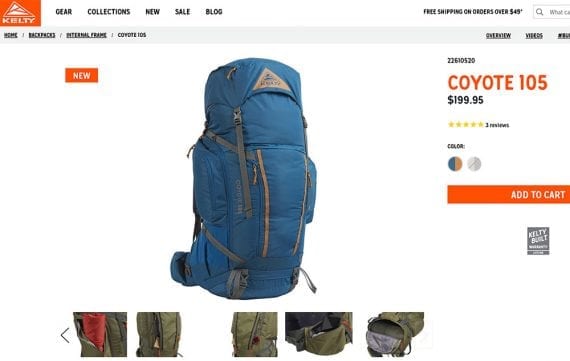
Product detail pages need pictures, and the Coyote 105 page has many of them.
Images help shoppers know how a product looks and imagine how it feels. This is critical since online shoppers cannot handle a product as they would in a physical store.
According to a 2019 eMarketer article (which was based on earlier research from Salsify), on average American online shoppers expect to see six product images on a product detail page. Two age groups — 18-to-24-year-olds and 35-to-44-year-olds — desired eight images.
Price and call-to-action. A simple call-to-action button (“Add to Cart”) and the price (“$199.95”) appears just below the images on mobile and to the right on desktop computers.
These elements are essential, so Kelty places them near the top. A returning shopper, for example, can use the product images and price to verify she has come to the right item.
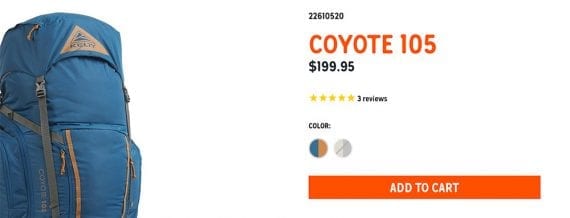
A price and call-to-action are essential. But they can also say something about the product. Shoppers expect relatively expensive items to be feature-packed and well made.
Written description and specifications. A product’s written description and specifications can be among the most critical elements. These textual sections provide specific, easy-to-understand information about the item. And they also play a significant role in search engine optimization as well as voice search.
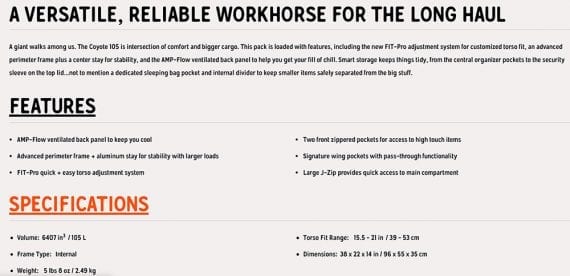
Written descriptions and specifications are important in communicating a product’s purpose, features, and benefits. Such descriptions also help with SEO.
Kelty provides product copy in two forms, prose and lists. First comes the prose.
A giant walks among us. The Coyote 105 is [at the] intersection of comfort and bigger cargo. This pack is loaded with features, including the new FIT-Pro adjustment system for customized torso fit, an advanced perimeter frame plus a center stay for stability, and the AMP-Flow ventilated back panel to help you get your fill of chill. Smart storage keeps things tidy, from the central organizer pockets to the security sleeve on the top lid…not to mention a dedicated sleeping bag pocket and internal divider to keep smaller items safely separated from the big stuff.
One could argue about how well the description is written or even how to write a high-converting product description. Regardless, Kelty calls out some of the backpack’s main features.
Next, this product detail page offers a few lists that make it easy to identify key buying criteria.
For example, the empty pack weighs five pounds eight ounces. This is vital info for someone who has to carry the Coyote 105. Next, we learn in a bullet point that its storage capacity is a massive 6,407 cubic inches.
Videos. Next, Kelty includes a product description video. It covers both the Coyote 105 and the smaller Coyote 85. The features of both packs are essentially the same, and it doesn’t detract from one to have it described with the other.
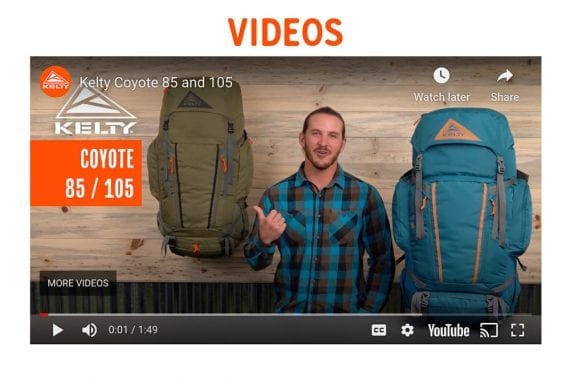
The product description video adds much to the page and is likely to be a favorite for shoppers.
Videos can take a product detail page to a new level. Shoppers find them helpful.
Reviews. Kelty rounds out the Coyote 105 product detail page with some social proof in the form of customer reviews. The Coyote 105 is a relatively new product. It has just three reviews at the time of writing. Nonetheless, they help to tell part of the product’s story.
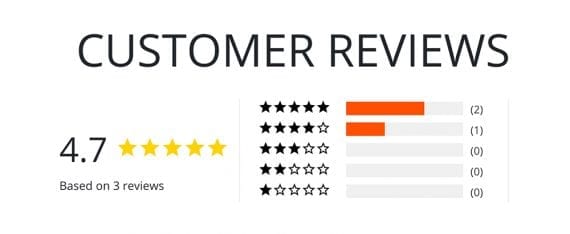
Social proof, such as customer reviews, can tell a powerful story about an ecommerce product.
Adios Written Descriptions?
On the Kelty Coyote 105 product detail page, the product video is augmented by written descriptions. However, some observers have suggested the written product descriptions could become obsolete.
While researching ecommerce product video practices, I found an article by Nick Rojas on the Pixel Productions blog that predicted: “written product descriptions will become obsolete.”
Rojas’s article turned up as the fourth organic result for the query “emerging ecommerce trends 2020 video” on a DuckDuckGo search results page. I conducted the query from the address bar in the Brave Browser on August 27, 2020. Although the article did not rank nearly as high in Google, the post has some search engine traction.

The article in question ranked well in DuckDuckGo.
The article’s third emerging ecommerce trend stated:
Another prediction about the future of ecommerce is that written product descriptions will become obsolete. According to studies conducted by Social Media Today, 60-percent of shoppers would rather watch a product video than read a product description when they’re shopping. This number is projected to increase over time. With this in mind, retail companies should focus on providing video product descriptions, as opposed to written ones.
However, suggesting the written product descriptions will become obsolete seems unlikely. I decided to find the source on Social Media Today.
The Social Media Today study cited may be an article by Mark Walker-Ford in May 2018. That article states, “60-percent of consumers would rather watch a product video than read a description,” but it stops short of suggesting that written descriptions are going away.
The Walker-Ford post cites an Invesp infographic as the source of the 60-percent figure. In turn, the infographic references a 2016 E-commerce Nation post, which says that the 60-percent figure comes from Single Grain, a digital marketing agency.
The Single Grain post in question was updated last year and no longer mentions this statistic. However, the Internet Archive had a copy of the article from September 2015.

The Internet Archives Wayback Machine lets you view web pages as they looked in the past.
It seems Single Grain got the information from Diode Digital. That page appears to require Flash. So for me, the trail ended here.
Sixty percent of consumers prefer video. That seems low. I would have expected that number to be much higher. But it doesn’t imply that written product descriptions will soon be obsolete.

